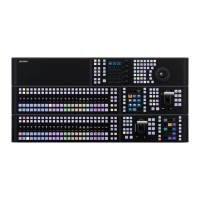429
• Set [Serial Tally 1] or [Serial Tally 2] when used as
a serial tally port.
For details, see “Setting a Serial Tally”
(page 439).
• [P-Bus], [Serial Tally 1], and [Serial Tally 2] can be
se
t for one port only on each control panel.
5
Press [OK].
6
Press the [Name] button and enter a port name (up to
16 characters) using the keyboard.
7
Press the [Select Panel] button and select a control
panel (Panel 1, Panel 2) from the pull-down list.
Setting a P-Bus Compatible Device
1
Open the Home > Setup > External Device > Serial/
Net Port Setting > P-Bus menu (19105.61).
2
Display the target control panel to set.
Select a tab to change the control panel to display.
[Panel 1] tab: C
ontrol panel 1
[Panel 2] tab: C
ontrol panel 2
The device name and response speed settings status
f
or each command are displayed.
3
Select the target device ID to set.
4
Press the [ID Name] button and enter a device name
(up to 8 characters) using the keyboard.
5
Press the [Delay Settings] button.
The [Delay Settings] window appears.
6
Set the command response speed.
Press the button for the command to set and enter a
resp
onse speed in the numeric keypad window.
Store:
Store command response speed
Recall: R
ecall command response speed
Trigger0 to 15:
Trigger command response speed
7
Press [OK].
To set a network port
You can set the IP address and port number of a network
po
rt.
1
Press the [IP Address] button and enter an IP address
using the keyboard.
2
Press the [TCP/IP Port] button and enter a port
number in the numeric keypad window.
Setting a VTR
1
Open the Home > Setup > External Device > Serial/
Net Port Setting > VTR menu (19105.62).
A list of ports is shown on the left and the settings
st
atus of the selected port is shown on the right.
2
In the list on the left, select the target port to set.
3
In the [TC Source] group, select a timecode source
(reference number for determining the tape position).
LTC: Use L
TC (Longitudinal Time Code).
When interpolation data is returned from a VTR,
use
that interpolation data.
LTC:VITC: Normal
ly use LTC, except when the
tape is moving at speeds at which LTC cannot be
read, use VITC.
When interpolation data is returned from a VTR,
use
that interpolation data.
VITC: Use VIT
C (Vertical Interval Time Code).
CTL: Use C
TL (Control) pulse or timer counter
pulse.
Use this only for a tape on which no timecode is
reco
rded.
4
In the list on the right, set the VTR constants of the
item.
Press the [Setting] button for an item to set and enter
a VT
R constant (00 to FF) in the numeric keypad
window.
Notes
Item Item description
VTR Constant
Blo
ck1 Byte1
HI-BYTE (DEVICE TYPE)
VTR Constant
Blo
ck1 Byte2
LO-BYTE (DEVICE TYPE)
VTR Constant
Blo
ck1 Byte3
HI-BYTE (FRAME) (PREROLL
TIME)
VTR Constant
Blo
ck1 Byte4
LO-BYTE (FRAME) (PREROLL
TIME)
VTR Constant
Blo
ck1 Byte5
EDIT DELAY (FRAME)
VTR Constant
Blo
ck1 Byte6
EE DELAY (FRAME)
VTR Constant
Blo
ck1 Byte7
OVER RUN (FRAME)
VTR Constant
Blo
ck1 Byte8
TRAJECTORY
VTR Constant
Blo
ck2 Byte1
TC READ DELAY (FRAME)

